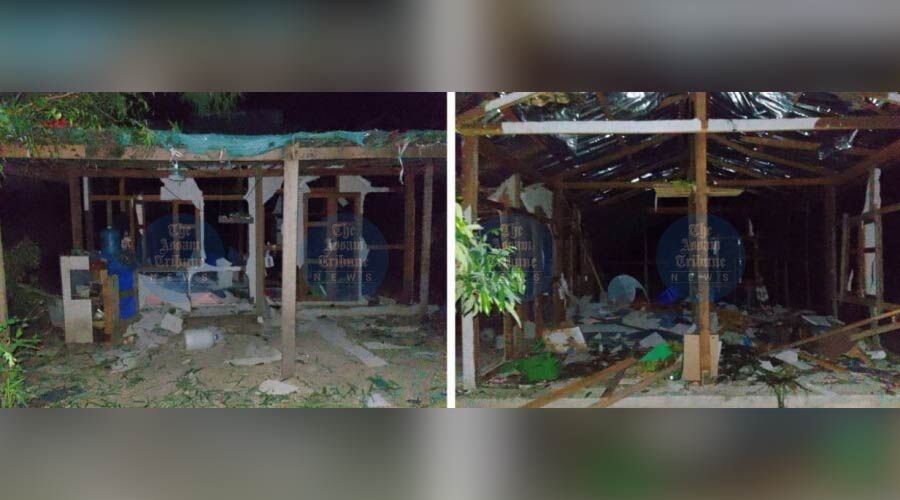Top Stories
Assam Leaders Urge Dialogue After ULFA-I Drone Strikes

Following reported drone strikes targeting the United Liberation Front of Asom-Independent (ULFA-I) camps in Myanmar, calls for negotiations with the banned group have intensified in Assam. The strikes, alleged to have been executed by Indian forces, have raised significant concerns among political leaders and student bodies about the potential for renewed violence.
Calls for Peace Talks Intensify
On July 14, 2023, former ULFA general secretary Anup Chetia urged both the central and state governments to pursue peace talks with ULFA-I instead of labeling the organization a terrorist group. Chetia emphasized the need for a political solution, stating, “I appeal to the government to open channels for negotiation with ULFA rather than focus on bringing them to justice.” He highlighted a recent conversation with ULFA-I commander-in-chief Paresh Barua, who informed him about casualties from the drone strikes.
Chetia recounted that during the attack, a member named Nayan Asom had instructed his comrades to take cover but chose to remain behind to care for ill comrades. Tragically, he lost his life in the process. Another casualty, Pradeep Asom, died during his last rites due to a subsequent drone strike. Chetia cautioned that retaliatory violence could disrupt the fragile peace in Assam, which has been relatively stable under Chief Minister Himanta Biswa Sarma.
“Assam has seen stability under Chief Minister Sarma. Investors are finally showing interest,” Chetia noted. “But if ULFA-I retaliates, it will shatter the environment of peace. I urge the Government of India or whoever is responsible to seek resolution through dialogue.”
Concerns from Student Bodies
The Asom Jatiya Yuba Chatra Parishad (AJYCP), a prominent student organization, echoed Chetia’s concerns. AJYCP president Palash Changmai warned that the airstrikes might undermine the delicate atmosphere that had been gradually developing toward negotiations. He pointed out that ULFA-I had refrained from militant activities for nine years, fostering hope for dialogue.
Changmai described the magnitude of the attack as similar to the Pulwama strike of 2019, asserting, “Over the years, about 18,000 to 20,000 youth have sacrificed their lives for this cause. The only way forward is through negotiation.”
In response to the strikes, Chief Minister Sarma clarified that the state police were uninvolved, stating, “There is no involvement of Assam Police. No attack was launched from Assam soil.” He urged caution, suggesting that verified facts would emerge, typically followed by official statements from the armed forces, which had yet to be issued at that time.
While the Indian Army has officially denied participation in the strikes, multiple sources confirmed to The Assam Tribune that the operations occurred in the early hours of July 14, targeting two key ULFA-I bases in Myanmar: the Diamond Camp near Hoyat village and a central mobile headquarters in Waktham. Reports indicate that over 100 drones were launched from forward bases of the 3 Corps, with reconnaissance and target coordination conducted over several days.
Defence spokesperson Lt Col Mahendra Rawat maintained, “There is no input from the Indian Army on such an operation.” As tensions rise, civil society groups are calling for restraint and a renewed commitment to dialogue in order to prevent further escalation and preserve the peace that has taken years to achieve.
-

 World5 months ago
World5 months agoSBI Announces QIP Floor Price at ₹811.05 Per Share
-

 Lifestyle5 months ago
Lifestyle5 months agoCept Unveils ₹3.1 Crore Urban Mobility Plan for Sustainable Growth
-

 Science4 months ago
Science4 months agoNew Blood Group Discovered in South Indian Woman at Rotary Centre
-

 World5 months ago
World5 months agoTorrential Rains Cause Flash Flooding in New York and New Jersey
-

 Top Stories5 months ago
Top Stories5 months agoKonkani Cultural Organisation to Host Pearl Jubilee in Abu Dhabi
-

 Sports4 months ago
Sports4 months agoBroad Advocates for Bowling Change Ahead of Final Test Against India
-

 Science5 months ago
Science5 months agoNothing Headphone 1 Review: A Bold Contender in Audio Design
-

 Top Stories5 months ago
Top Stories5 months agoAir India Crash Investigation Highlights Boeing Fuel Switch Concerns
-

 Business5 months ago
Business5 months agoIndian Stock Market Rebounds: Sensex and Nifty Rise After Four-Day Decline
-

 Sports4 months ago
Sports4 months agoCristian Totti Retires at 19: Pressure of Fame Takes Toll
-

 Politics5 months ago
Politics5 months agoAbandoned Doberman Finds New Home After Journey to Prague
-

 Top Stories5 months ago
Top Stories5 months agoPatna Bank Manager Abhishek Varun Found Dead in Well









